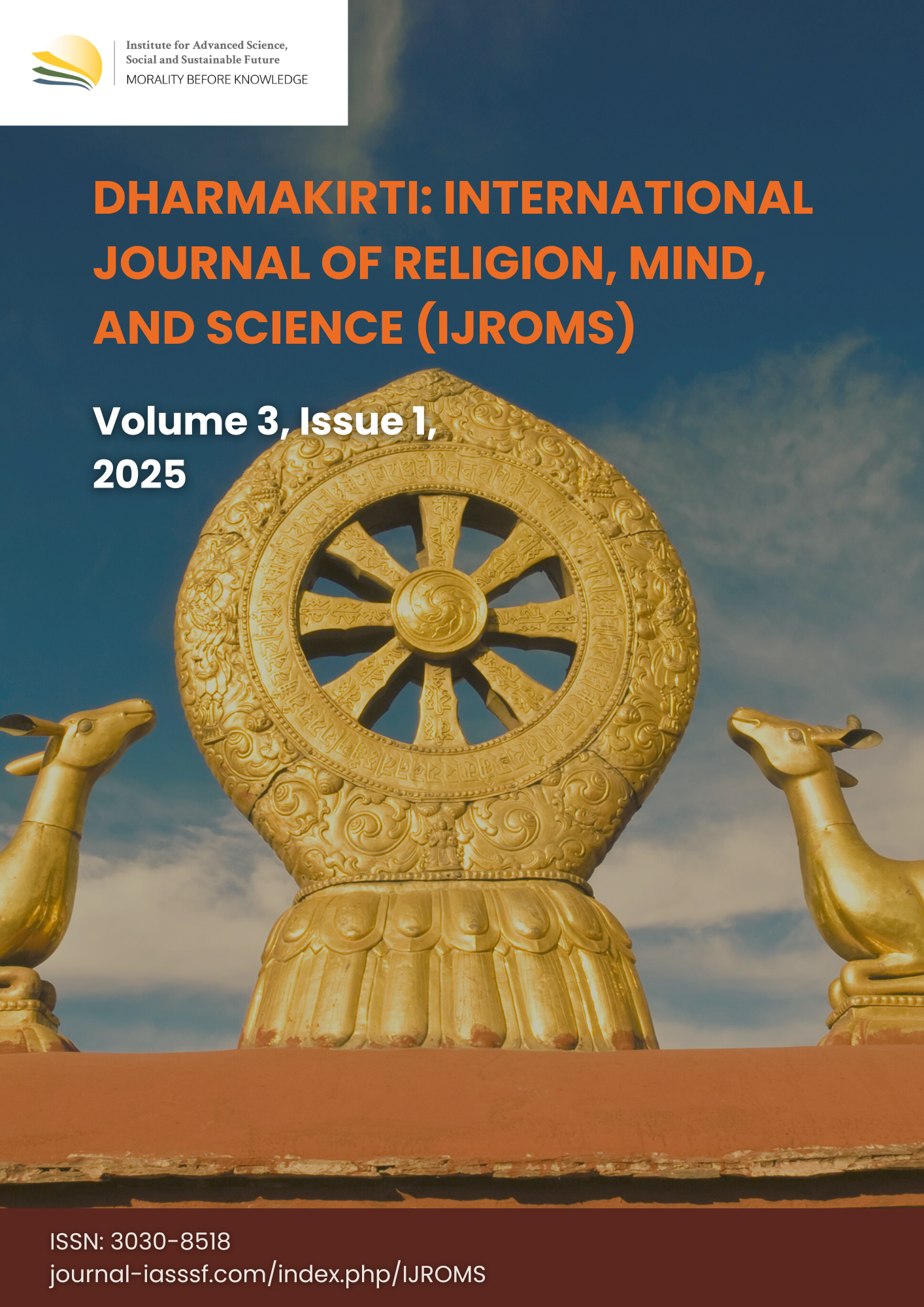The conservation of the white cattle of Taro as a representation of Prāṇī-Dharma values, biodiversity preservation, and religious heritage
DOI:
https://doi.org/10.61511/ijroms.v3i1.2025.2308Keywords:
white cattle, Prāṇī-Dharma, Bali, Hinduism, sacred animalsAbstract
Background: The breeding of white cattle in Taro Village, Bali, is not merely an agricultural or economic activity, but one deeply intertwined with spiritual values rooted in the concept of Prāṇī-Dharma. In this context, white cattle are revered not only as symbols of prosperity and wealth, but also as sacred beings that embody harmony between humans and nature. This study aims to explore how the breeding of white cattle in Taro functions as a representation of Prāṇī-Dharma values, particularly in relation to the preservation of tradition and ecology. Methods: Employing a qualitative case study approach, this research involved in-depth interviews with breeders, religious figures, and local community members, as well as field observations of rituals and cattle-rearing practices. The data were analyzed thematically to identify the connections between Hindu spiritual concepts and the practice of white cattle breeding. Finding: The findings reveal that the breeding of Taro’s white cattle reflects an integration of spiritual and ecological dimensions within the local community. The white cattle are regarded as symbols of purity and environmental balance, protected through the principles of Ahimsa (non-violence) and Karuna (compassion), which lie at the heart of Prāṇī-Dharma. This practice also plays a vital role in the conservation of living beings and the preservation of local cultural traditions. Conclusion: The study concludes that the breeding of white cattle in Taro is not only a conservation practice but also a means of reinforcing moral and spiritual values within Hindu society. This research contributes to the understanding of the relationship between divine ecology and traditional conservation, enriching the discourse on how religion and local culture support environmental sustainability.
References
Ardiyani, L. P. C., Pitriani, K., & Jero, N. W. J. (2025). Rejang Pedawa dance as a medium for ethnopedagogical-based adolescent learning. Dharmakirti: International Journal of Religion, Mind and Science, 2(2), 92-102. https://doi.org/10.61511/ijroms.v2i2.2025.1311
Apollo, M., Wengel, Y., Schänzel, H., & Musa, G. (2020). Hinduism, ecological conservation, and public health: What are the health hazards for religious tourists at Hindu temples? Religions, 11(8), 416. https://doi.org/10.3390/rel11080416
Awasthi, A. (2021). A reinterpretation of Hindu spirituality for addressing environmental problems. Religions, 12(5), 358. https://doi.org/10.3390/REL12050358
Clifton, W. G. (2023). Sustainability policy and the stage of divine play: Hindu philosophy at the nexus of animal welfare, environment, and sustainable development. Journal of Animal Ethics, 13(2), 84–97. https://doi.org/10.5406/21601267.13.2.08
DeJonckheere, M., Vaughn, L. M., James, T., & Schondelmeyer, A. (2024). Qualitative thematic analysis in a mixed methods study: Guidelines and considerations for integration. Journal of Mixed Methods Research, 18(3), 294–308. https://doi.org/10.1177/15586898241257546
Gadgil, M. (2023). Ecosystem people, biosphere people, ecological refugees. Social Change, 53(1), 7–28. https://doi.org/10.1177/00490857231152416
Jemiwi, J., & Dharma, N. K. S. A. (2025). Hidup Selaras dengan Dharma: Langkah Kembali ke Rumah Jiwa. PT. Dharma Pustaka Utama.
Kholijah, K., Darwati, S., Ulum, M. F., Londra, I., Noor, R. R., & Jakaria, J. (2024). Investigation of polymorphism and expression of the tyrosinase (TYR) gene as a gene controlling coat color in Bali cattle. Journal of the Indonesian Tropical Animal Agriculture, 49(4), 297–306. https://doi.org/10.14710/jitaa.49.4.297-306
Maduriana, I. M., & Gata, I. W. (2021). Integrasi pendidikan biologi dalam konservasi lembu putih Taro berbasis kearifan lokal. Jurnal Pedagogi dan Pembelajaran, 4(3), 412–423. https://doi.org/10.23887/jp2.v4i3.41349
Melaku, A., Ivars, J. P., & Sahle, M. (2023). The state-of-the-art and future research directions on sacred forests and ecosystem services. Environmental Management, 71(6), 1255–1268. https://doi.org/10.1007/s00267-023-01790-4
Praveena, T., & Raju, R. R. (2023). Achieving environmental harmony: An analysis based on the narratives from Mahabharata. Theory and Practice in Language Studies, 13(2), 441–446. https://doi.org/10.17507/tpls.1302.19
Putra, W., Margawati, E. T., Furqon, A., Puja, I., & Hasbi, H. (2024). Genetic variation in two phenotypes of Bali cattle (Bos javanicus) inferred by (AG)9C ISSR marker. Tropical and Subtropical Agroecosystems, 27(52), Article 5213. https://doi.org/10.56369/tsaes.5213
Pradhan, A., & Ormsby, A. A. (2020). Biocultural conservation in the sacred forests of Odisha, India. Environmental Conservation, 47(3), 190–196. https://doi.org/10.1017/S0376892920000181
Saryal, R. (2022). Beyond environmental science: Climate action in Hindu religion and Sant Mat tradition. International Social Science Journal, 72(4), 423. https://doi.org/10.1111/issj.12331
Saunders, C. H., Sierpe, A., von Plessen, C., Kennedy, A. M., Leviton, L., Bernstein, S., Goldwag, J., King, J. R., Marx, C., Pogue, J. A., Saunders, R. K., Van Citters, A. V., Yen, R., Elwyn, G., & Leyenaar, J. (2023). Practical thematic analysis: A guide for multidisciplinary health services research teams engaging in qualitative analysis. BMJ, 380, e074256. https://doi.org/10.1136/bmj-2022-074256
Shiferaw, A., Hebo, M., & Senishaw, G. (2023). The spiritual ecology of sacred landscapes: Evidence from sacred forests of the Sebat Bête Gurage, Central-South Ethiopia. Cogent Social Sciences, 9(1). https://doi.org/10.1080/23311886.2023.2210900
Sinthumule, N. I., & Mashau, M. L. (2020). Traditional ecological knowledge and practices for forest conservation in Thathe Vondo in Limpopo Province, South Africa. Global Ecology and Conservation, 22, e00910. https://doi.org/10.1016/j.gecco.2020.e00910
Sullivan, M. K., Browne, L., Penagos Zuluaga, J. C., Liu, J., Surendra, A., & Estrada-Villegas, S. (2023). Sacred forest biodiversity conservation: A meta-analysis. Conservation Science and Practice, 5(2), e13055. https://doi.org/10.1111/csp2.13055
Sherma, R. (2021). Relationality and revelation: Early Hindu ecological visions. Religions, 12(7), 465. https://doi.org/10.3390/rel12070465
Sharma, M. (2023). Hindu nationalism and right-wing ecology: RSS, Modi and motherland post-2014. Studies in Indian Politics, 11(1), 102–117. https://doi.org/10.1177/23210230231166197
Swer, G. M. (2020). Nature, gender and technology: The ontological foundations of Shiva’s ecofeminist philosophy. Comparative and Continental Philosophy, 12(2), 1–14. https://doi.org/10.1080/17570638.2020.1780685
Sharma, P. (2020). Rituals and ecology: A study of Hindu practices. Routledge.
Surpi, N. K. (2020). Śivagrha (Prambanan Temple) as an Archetype of Hindu Theology in Nusantara (An Endeavor to Discover Hindu Theological Knowledge through Ancient Temple Heritage). Analisa: Journal of Social Science and Religion, 5(1), 107-122. https://doi.org/10.18784/analisa.v5i1.1024
Surpi, N. K., Avalokitesvari, N. N. A. N., Untara, I. M. G. S., & Sudarsana, I. K. (2021). Interpretation of Symbols, Veneration and Divine Attributes in Dieng Temple Complex, Central Java. Space and Culture, India, 8(4), 60-77. https://doi.org/10.20896/saci.v8i4.991
Surpi, N. K. (2022). The Interpretation of Vaiṣṇava Divinity Doctrine by The Maha Warga Bhujangga Waisnawa in Bali Island. Proceeding of 9th International Conference on Nusantara Philosophy (ICNP), 1-11
Surpi, N. K. (2022, December). Nyepi and the Efforts to Save the Environment. In IOP Conference Series: Earth and Environmental Science (Vol. 1111, No. 1, p. 012084). IOP Publishing. https://doi.org/10.1088/1755-1315/1111/1/012084
Zagonari, F. (2020). Comparing religious environmental ethics to support efforts to achieve local and global sustainability: Empirical insights based on a theoretical framework. Sustainability, 12(7), 2590. https://doi.org/10.3390/su12072590
Published
How to Cite
Issue
Section
Citation Check
License
Copyright (c) 2025 Ni Wayan Sri Rahayu, Puspo Renan Joyo, Ni Wayan Sariani Binawati

This work is licensed under a Creative Commons Attribution 4.0 International License.















